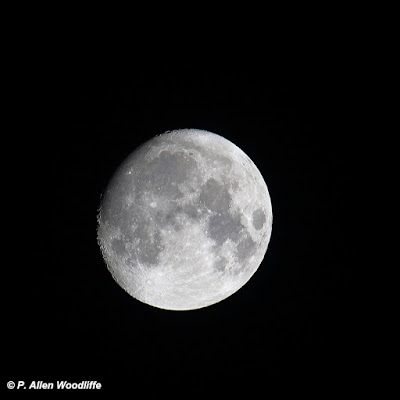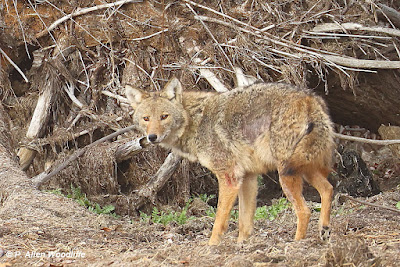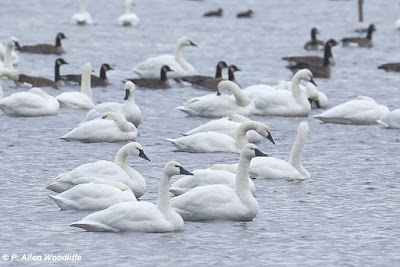I've heard lots of coyotes over the years, mainly when I have been out at night with the black lights. They may have been howling at the moon, or just enjoying communication with others of their kind.
On occasion I have even seen them during the day, but usually from a great distance and the photos are only possible due to a high powered telephoto lens to begin with, and then further cropping on the computer. My previous blog post featured some of those, as I was discussing their impacts on deer, turkeys and other wildlife of the area. I had never photographed a coyote inside the confines of Rondeau. Until yesterday.
I had been looking for an Eastern Phoebe along the edge of Rondeau Bay, near the boat ramp, where one had been seen on a couple of occasions recently. I didn't see the phoebe, but while scanning the shoreline, I noticed this canine resting comfortably about 75 metres from where I was. It was sheltered from the brisk easterly wind, and able to enjoy some sunlight, whenever the sun broke through the cloud cover.It was aware of me, as I am sure it had seen regular boater/hunter activity at the boat ramp as it was the main access for hunters to get to their duck blinds somewhere on the bay. Therefore it didn't seem to be all that concerned about my presence, and continued to stay put. But it eventually got up, stretched and scratched itself....
...and then slowly sauntered back into a tangle of shrubs and fallen trees. I watched this coyote for a good 15-20 minutes. Normally a coyote would scamper out of sight almost immediately when a human comes anywhere near that close, presumably since beyond the park's boundaries, they are frequently hunted. But inside the park, they are not hunted at all. Even then they don't typically remain so visible and stationary for so long.
I had been at Rondeau for a good long walk, in preparation for the upcoming Christmas Bird Count. Of the 4 counts I typically do each year, the Rondeau one is always the most challenging in terms of hiking conditions. For about three decades or more, my territory includes starting off walking the south beach all the way to Erieau and back. Hiking conditions due to snow, ice and wind can be challenging, especially carrying a 'scope. The south beach is a relatively narrow strip of beach, giving great views of the lake as well as the south end of both the marsh and bay. It has been a very rewarding area to cover, in spite of the challenges. Over the years I have seen things like Purple Sandpiper, Red Phalarope, Snowy Owl, Harlequin Duck and King Eider on this count.
And then up until just a few years ago, when I was finished with the south beach area by around mid-day, I would quickly head to the north end of the park, drive part way out the Marsh Trail and walk it to the end, including a side trip to Long Pond. All told, the day would encompass roughly an 18 km hike, carrying the scope and/or camera. The Marsh Trail has also had some notable birds on this count, including Sage Thrasher, American Avocet, Western Sandpiper and Northern Shrike, among others.
The Marsh Trail has been relatively off limits over the past few years, due to the major erosion problems at the north end. So I have not covered the marsh in the last couple of years.
I did venture out part way along the south beach a few days ago. With no snow or ice to contend with, it seems relatively peaceful and accessible, with some rather wide beach areas now that the water levels of the lake have dropped a bit this year. It looks promising, if my energy and legs can stand it. Walking on sand for that distance dressed in winter garb and carrying a scope takes its toll, especially depending on the weather.
On another occasion, since there was a brisk east wind and it was a non-hunting day, I walked part way out the Marsh Trail. Even after a trek of about 4 km, the birds were not very plentiful, nor cooperative for the camera. I did see three sub-adult Bald Eagles, but only got a single photo of one of them leaving its perch almost immediately after I saw it.
Elsewhere in the park, I came across a clump of the distinctive leaves of the rare Puttyroot orchid. I had better success photographing them since they were not going anywhere. This was a new population that I discovered late last winter.
I've also spent a bit of time meandering around the former Dover Twp, partially to see what birds are out there in preparation for the upcoming St. Clair NWA Christmas Bird Count on New Year's Day, and also hoping to see my first of the season Snowy Owl. The snowies seem not to have arrived yet this season, but things like Tundra Swans are quite abundant in or near the NWA, and even some Sandhill Cranes are still around.
The shrubby hedgerow where the Great Blue Herons were taking shelter a few days ago, which I featured in a recent blog post, is currently being ripped up. Another tree line being dismantled, allowing the brisk wind to blow the topsoil. I noted one or two spots earlier today where the blowing topsoil was making visibility for driving a bit difficult. Such are the conditions of Chatham-Kent. Sigh.....
If you would like to subscribe, or unsubscribe, to Nature Nuggets, send an email to: prairietramper@gmail.com















Interesting to see a coyote that doesn't run away.
ReplyDeleteYes, I was quite surprised that it was so tolerant considering how much civilization and human activity there was so close to it. But I'm certainly glad it gave me some excellent photo opportunities!
Delete